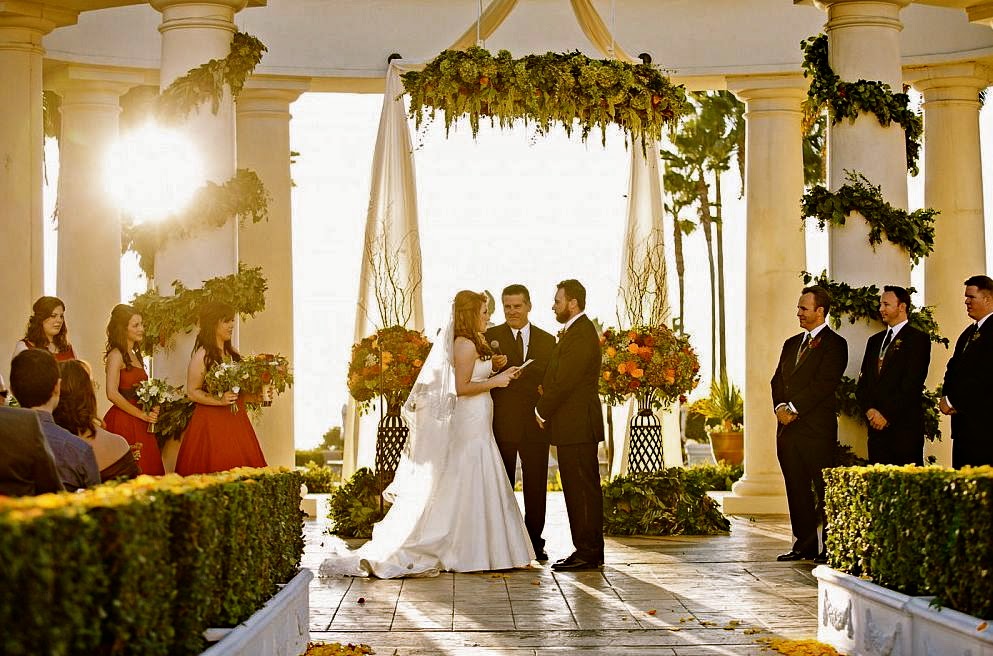 |
| Kelly's and Casey's first dance as a married couple. |
Though the statistics tell us that fewer couples are getting married these days, and are merely cohabitating, my calendar and my Twitter feed paint a different picture; That tying the knot and weddings in general, are more popular than ever now. The most recent wedding I attended, was by far one of the most fun and the most unique weddings I have ever been too.
 |
| The Casey's groomsmen's waistcoats were ordered from the UK, as that was the only place my sister in-law and niece could find his family tartan. |
Being a family member's wedding, my niece's to be exact, I thought it would be rather similar to my nephew's wedding back in March. Both were at beautiful, beach locations (my nephew's wedding was at The Resort at Pelican Bay and my niece's at The St. Regis Monarch Beach Resort and both were fortunate to have unseasonably warm weather). Both had Irish and Italian traditions woven into the ceremonies and foods. Both my nephew and niece were marrying a "Casey." Both weddings were lovely. But that's where the similarities ended.
 |
| Kelly, with my big brother, at her engagement party and then dancing with her at the wedding reception. |
Now, my older brother and I have always shared the same sense of humor. He shares it with his daughter as well. This wedding had Kelly's personality and sense of humor written all over it, along with her mother's excellent taste.
We mingled with family members we hadn't seen for ages, and by the time we sat down and looked through our programs, I knew we would remember this particular wedding very fondly.
The "early drafts" of their "personalized vows" were funny and everyone was commenting on the Mad Libs... before, during and after the wedding ceremony.
 |
| The program's"early drafts" of their vows... |
Not only was the reception dining room beautiful, but according to the enthusiastic St. Regis employee who showed us the way to the room, "Everything was brought in for this wedding! It's really something. Even the furniture in this lobby area was brought in! It is normally pretty empty, other than large potted plants." He then took us into the dining area, which was still being set up. He said he had wanted to see it after it was done, and he pointed to the two large family crests hanging on the wall. "Those were brought in specially for this wedding too. It's fantastic!" I had to agree. When I had lunch with my sister in-law and niece a few weeks back, they confirmed what I had been told about everything they had carefully chosen to suit them, right down to the furniture.
Kelly and her mother, my sister in-law Peggy, went out and chose comfortable furniture to be brought in for those guests who wanted a break from the music or just wanted to relax peacefully after dinner, and away from the merriment. My brother and his wife had chosen seating for the eldest family members (the grandparents, great aunts, great uncles and such) so that they would not be sitting by any loud speakers blasting music at them, and so that they had easy access to and from the dining area.
Large baskets with complimentary flip-flop sandals, in every imaginal size and color, were out in the lounge area after the dancing started, so that we could relieve ourselves of uncomfortable heels and dress shoes and really enjoy ourselves. "Alice in Wonderland" inspired treats and beer for guests to drink and nibble on, had tags hanging from them, reading "Drink Me" and "Eat Me" out in the lounge area too. Kelly and her mother, Peggy, really did think of everything to make their guests feel comfortable.
 |
| The Irish Ale was offered up with miniature cookies decorated with the Italian family crest. |
But that was after a delicious dinner, along with entertainment by traditional Irish dancers, the traditional father daughter dance (my brother's speech and toast to the couple, was funny and touching... I really loved it) and a dance with the groom and his mother, the tossing of the bouquet and garter, a most unusual wedding cake of assorted goodies (Irish porter cake, Italian almond cookies, spumoni flavored macarons, chocolate, pistachio and cherry chocolate fountain and dipping bites), a taco bar, a cigar bar, and my personal favorite of the evening, grilled cheese sandwiches with thick cut bacon that were brought out by the wait staff to each table later in the evening. Those were delicious!
 |
| I asked Cliff, who often judges wines at local and international competitions, if he liked the wine choice and I got this goofy grin. I guessed that was a "yes." |
 |
| The bride and groom share a laugh before cutting the cake. I don't think I have ever seen my niece looking so happy and relaxed. |
 |
| Dancing the night away. |
































